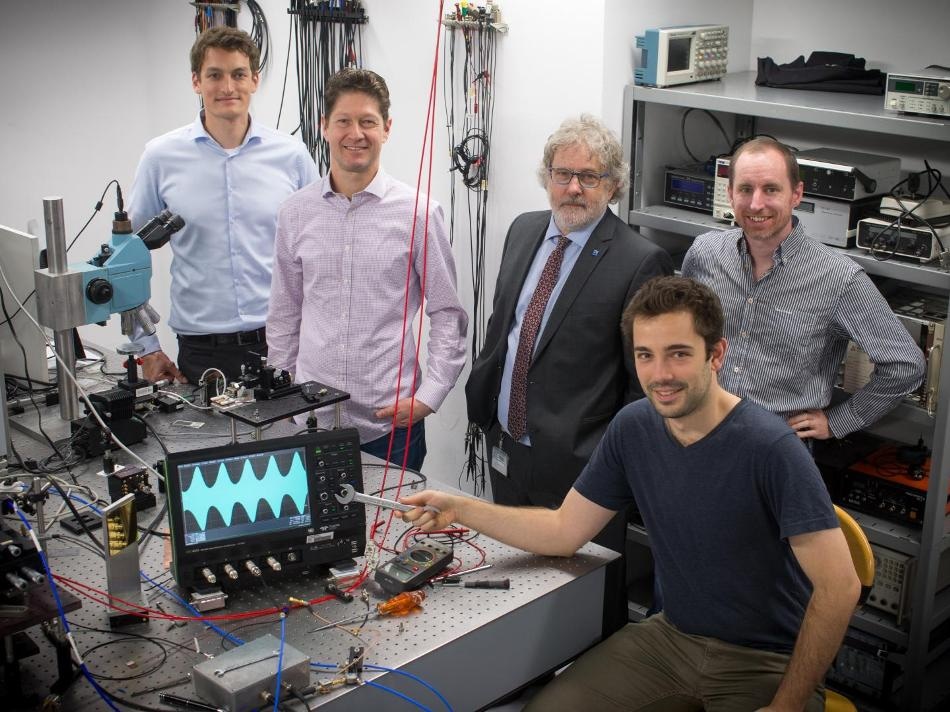Dec 11 2018
A majority of the lasers have just one color. All the photons emitted by a laser have precisely the same wavelength. However, there exist lasers that emit more complicated light.
 The team at TU Wien: Benedikt Schwarz, Aaron Maxwell Andrews, Gottfried Strasser, Johannes Hillbrand, and Hermann Detz (left to right). (Image credit: TU Wien)
The team at TU Wien: Benedikt Schwarz, Aaron Maxwell Andrews, Gottfried Strasser, Johannes Hillbrand, and Hermann Detz (left to right). (Image credit: TU Wien)
If a laser light comprises of several different frequencies, with equal intervals in between, quite similar to the teeth of a comb, it is termed as a “frequency comb.” Frequency combs are ideal for the detection of a range of chemical substances.
At TU Wien (Vienna), this unique type of laser light is currently being used to allow chemical analysis on minute spaces—it is a millimeter-format chemistry lab. This innovative patent-pending technology can be used to create frequency combs on a single chip in a very simple and robust manner. The study has been published in the Nature Photonics journal.
A comb with a Nobel Prize
For many years, frequency combs have been in use. The Nobel Prize for Physics for the year 2005 was awarded for this technology.
The exciting thing about them is that it is relatively easy to build a spectrometer with two frequency combs. It is possible to make use of beats between different frequencies, similar to those that occur in acoustics, if you listen to two different tones with similar frequency. We use this new method, because it does not require any moving parts and allows us to develop a miniature chemistry lab on a millimetre scale.
Benedikt Schwarz, Head of the Research Project, Vienna University of Technology.
Frequency combs are developed at the Vienna University of Technology using quantum cascade lasers. These unique lasers are semiconductor structures containing several different layers. Upon applying electrical current through the structure, light in the infrared range is emitted by the laser. It is possible to control the characteristics of the light by tuning the geometry of the layer structure.
“With the help of an electrical signal of a specific frequency, we can control our quantum cascade lasers and make them emit a series of light frequencies, which are all coupled together,” stated Johannes Hillbrand, first author of the publication. The phenomenon is remindful of swings on a rocking frame—rather than pushing individual swings, the scaffolding can be made to wobble at the right frequency, making all the swings to oscillate in specific coupled patterns.
“The big advantage of our technology is the robustness of the frequency comb,” stated Benedikt Schwarz. In the absence of this technique, the lasers are highly sensitive to disturbances, which are unavoidable outside the lab—for example, temperature fluctuations, or reflections that send a portion of the light back into the laser. “Our technology can be realized with very little effort and is therefore perfect for practical applications even in difficult environments. Basically, the components we need can be found in every mobile phone,” stated Schwarz.
The molecular fingerprint
It is a critical fact that the quantum cascade laser produces a frequency comb in the infrared range since several of the most important molecules can be detected in the best possible way by light in this frequency range.
Various air pollutants, but also biomolecules, which play an important role in medical diagnostics, absorb very specific infrared light frequencies. This is often referred to as the optical fingerprint of the molecule. So, when we measure, which infrared frequencies are absorbed by a gas sample, we can tell exactly which substances it contains.
Johannes Hillbrand, Study First Author, Vienna University of Technology.
Measurements in the microchip
Because of its robustness, our system has a decisive advantage over all other frequency comb technologies: it can be easily miniaturized. We do not need lens systems, no moving parts and no optical isolators, the necessary structures are tiny. The entire measuring system can be accommodated on a chip in millimeter format.
Benedikt Schwarz, Head of the Research Project, Vienna University of Technology.
This leads to splendid application concepts: the chip can be placed on a drone to measure air pollutants. Chips affixed to the wall could search for traces of explosive substances in buildings. They can be used in medical equipment for the detection of diseases through the analysis of chemicals in the respiratory air.
The innovative technology has already been patented. “Other research teams are already highly interested in our system. We hope that it will soon be used not only in academic research, but also in everyday applications,” stated Benedikt Schwarz.